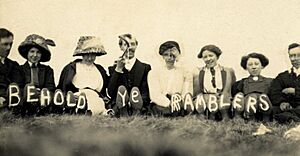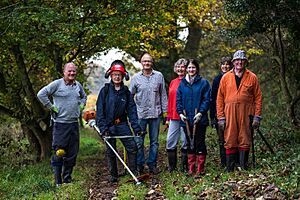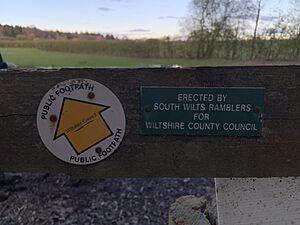The Ramblers facts for kids
 |
|
| Founded | 1 January 1935 |
|---|---|
| Type | Charity |
| Focus | Promoting walking |
| Headquarters | London |
| Origins | United Kingdom |
|
Area served
|
United Kingdom |
| Product | Walking |
| Method | Funding |
|
Members
|
101,842 |
|
Chief executive officer
|
Ross Maloney |
|
Key people
|
Tom Stephenson |
The Ramblers is a special charity in Great Britain that helps people enjoy walking. It's also a group with about 100,000 members. These members and many volunteers work hard to keep walking paths open and safe. The Ramblers started in 1935. Their main goal is to make sure everyone can explore the beautiful British countryside.
Contents
How the Ramblers Started
Walking in the countryside, also called rambling, became very popular in the 1800s. Many people living in busy towns and cities loved walking. It helped them escape pollution and daily stress. But it was getting harder to access the countryside. Landowners were closing off their land. So, many walking clubs started to fight for walkers' rights. These groups grew from the mid-1800s until the 1930s.
In 1931, a group called the National Council of Ramblers' Federations was formed. Walkers felt they needed a national group to speak for them. On April 24, 1932, some frustrated walkers held a large protest. It was called the mass trespass of Kinder Scout. Kinder Scout is the highest point in the Peak District. During this protest, some people argued with gamekeepers. Five walkers were even arrested. The National Council of Ramblers' Federations did not support this protest. But many people see this event as a very important moment for the Ramblers.
In 1934, the Council decided to change its name. This led to the official start of the Ramblers' Association on January 1, 1935. The first Ramblers' office opened in Liverpool in 1938. Ten years later, they hired Tom Stephenson as a full-time secretary. He was a big supporter of open access to the countryside. He also helped create the first long-distance path in Britain, the Pennine Way.
A politician named Hugh Dalton loved the outdoors. He was president of the Ramblers' Association for a time. Dalton cared about the environment before it was a common idea. In 1946, he helped create the National Land Fund. This fund helped pay for national parks. In 1951, he approved the Pennine Way. This path added many miles of public walking routes.
What the Ramblers Believe In
The Ramblers believe that walking is good for everyone. They think walking in the countryside and cities is a right. They also say that Britain's public paths are a valuable part of its history. They believe that local authorities should invest in these paths.
Since it started, the Ramblers has worked for the right to access green spaces. This helped create the right to walk on about 8% of land in England. This was made possible by the Countryside and Rights of Way Act 2000. They also helped create the England Coast Path. In Scotland, a law in 2003 made traditional walking rights official. This makes Scotland one of the best places in Europe for walkers.
The Ramblers want a country where everyone can enjoy the outdoors on foot. They believe in great walks for all people, no matter their age or background. They encourage everyone to be welcoming, positive, and responsible towards nature.
How the Ramblers Works
The Ramblers is a charity registered in England, Wales, and Scotland. A group of up to 15 trustees leads the charity. Scotland and Wales have their own local groups. At a local level, there are 485 local Groups and 59 regional Areas. These groups organize activities for members and volunteers. Each group has its own rules but works as part of the main Ramblers organization.
On April 1, 2023, Amar Latif, a blind adventurer, became the president of the Ramblers. Before him, the writer and DJ Stuart Maconie was president for six years.
What the Ramblers Has Achieved
Under Tom Stephenson's leadership, the Ramblers helped create the National Parks and Access to the Countryside Act 1949. This law led to the creation of National Parks and National Trails. It also created official maps of public paths in England and Wales.
More recently, the Ramblers helped create new national parks. These include the South Downs and New Forest in the early 2000s. The charity has also been key in developing national trails.
A big goal for the Ramblers was achieved in 2000. The Countryside and Rights of Way Act was passed. This law gives people the freedom to walk in certain open countryside areas in England and Wales.
The Ramblers has also pushed for access to the entire coast of England and Wales. They helped get government money in 2015 to finish the England Coast Path by 2020.
More and more, Ramblers volunteers help maintain footpaths across Great Britain. They work with local authorities to keep paths clear. This has helped maintain famous paths like the Pennine Way, the Pilgrims' Way, and Offa's Dyke. They also help with many shorter paths.
The Ramblers is recognized as the main group for "Rambling" in England. This is alongside the Long Distance Walkers Association.
Campaigns and Protecting Paths
Throughout its history, the Ramblers has worked to make sure everyone can access well-kept green spaces for walking. They always try to protect the rights of walkers.
One famous case involved a millionaire named Nicholas Van Hoogstraten. He had a long dispute with the Ramblers. In 1992, he built a fence and other things across a public footpath on his land. Local Ramblers protested. After a 13-year legal battle, the path was finally reopened on February 10, 2003.
Today, the Ramblers continues to defend walkers' rights. For example, they oppose plans to make trespassing a crime. They also oppose closing some railway crossings if the new path is not safe for walkers.
In 2015, the Ramblers launched "The Big Pathwatch." This project checked the condition of paths in England and Wales. Over 3,000 volunteers found 59,000 problems. They found that 56% of paths were good, 35% needed work, and 9% were hard or impossible to use. Ramblers volunteers continue to fix these paths.
A law said that all unrecorded paths created before 1949 needed to be officially recorded by January 1, 2026. The Ramblers trained more volunteers to find these "lost paths." They started a campaign called "Don't Lose Your Way" to save them.
The Ramblers works to make sure laws help people connect with nature. This includes green neighborhoods in cities and well-maintained public paths. They also want good signs to help people find their way.
The organization promotes good city planning. They want more green walking routes in towns and cities. Examples include the Walk London Routes and the Manchester Green Trail Network.
The Ramblers also promotes "Walking For Health" programs. These programs encourage people with health conditions to walk more.
The Ramblers is part of the Walking and Cycling Alliance. They work together to campaign for better walking and cycling.
Enjoying a Walk with the Ramblers
Ramblers groups organize led walks. Some walks are for specific age groups, like people in their 20s and 30s. This has helped attract younger members. There are also special groups for city walking, like the Metropolitan Walkers.
Walks come in different lengths:
- Short walks: 3 to 4 miles (about 6 km)
- Medium walks: 5 to 6 miles (about 10 km), or 7 to 9 miles (about 14 km)
- Longer walks for experienced walkers: 10 to 15 miles (about 24 km)
Walk leaders consider how difficult the path is. They check for hills, stiles (steps over fences), and busy roads. Leaders walk the route beforehand to make sure it's safe and enjoyable.
The Ramblers also offers "Ramblers Routes." These are walking routes with digital maps. They include detailed directions, interesting places to see, and information about how high the path goes.
See Also




